Production Application of Flat Solderable Tin Finishes: Some Practical Considerations
Flat solderable tin finishes offer important benefits to the assembly industry. From a fabricator's standpoint, the technology is relatively new, and there are some important considerations for production scale-up. Precisely and reliably measuring the tin thickness and solderability enables both suppliers and users to invoke and meet the required specifications and quality metrics...
The increasing need to achieve production capability on 0.4 mm pitch technologies and beyond with high assembly yields and improved solder joint reliability is driving further changes in surface finishes. This drive for change is also met by environmental challenges, largely represented by the elimination of lead, and is additionally coerced by pressures to drive down costs. As a consequence, a new generation of immersion metal finishes is pervading the electronics industry. These finishes include silver and tin variants, which have the particular advantage of common and/or compatible base metallurgies with the solders and pastes applied during assembly. This benefit extends not only to lead containing (63/37) products but also to lead-free commodity or solder alloys.
The current issues with interfacial stress fractures affecting array components, mainly BGAs (ball grid array) but also QFPs (quad flat pack), have been widely reported. These have served not only to fuel the quest for alternatives to nickel/gold plating, but have also heightened the awareness of the critical performance and reliability questions associated with surface finishes.
Such change is needed, but the engineering support required for testing and commissioning new materials presents a serious but mandatory burden on the OEM and EMS industries. However, this is only one aspect of the impact of the progressive change in surface finishing. The integration of such new processes within the PWB fabrication sector also presents some significant challenges. The board maker has to be able to install the process with minimal cost impact to the board. The new process has to be compatible with existing manufacturing procedures, or they have to be readily adjustable to accommodate the new system. The process and procedures have to be quickly optimized so that the finish can be applied consistently and reliably. The product has to meet the increasingly stringent quality assurance standards, and the appropriate methodologies and metrics have to be put in place.
The new process has to run consistently, reliably and measurably. With any new manufacturing technology within the PWB industry, one other important challenge is also leveled at the industry as a whole. How can the industry and its consortia of task forces, study groups and committees come to terms with the benchmarking needed? How can the specialty chemical vendor, the board fabricator, the assembler and the OEM understand the impact of the new process? How can they work in synergy to capture the benefits, guard against the threats and complete a win/win selection procedure? These are some of the challenges that the flat solderable immersion tin finish technology has had to address.
Challenges for the Immersion Tin Finish
The benefits and challenges of planar tin finishes have been reported. The impact on the OEM and assembler is critical. The tin system described in this article was first introduced into the European market during late 1993 and was more latterly promoted into the North American market from 1997. When installing this type of process, some of the key challenges that need to be confronted and addressed by a board fabricator are as follows:
1. Should the system be installed in a dip or conveyor system, particularly for high aspect ratio holes or thick boards?
2. How well can the process be controlled to give a consistently solderable finish?
3. What are the response variables for the parameters used to drive the process?
4. What are the expected plating distribution profiles?
5. How can the deposit thickness be quickly and accurately measured?
6. Is the deposit compatible with or can it be damaged by an electrical test?
7. Can effective supply specifications and quality metrics be agreed between the PWB fabricator and the customer?
8. Can the process be continuously used for minimal waste disposal?
9. How well does the new process integrate into the manufacturing sequence?
10. What is the impact on the PWB materials e.g. LPSM, legend, hole-plug, etc?
11. How clean is the surface in terms of ionics, and how can rinsing be optimized?
12. Can different types of pretreatment be applied with success?
13. Do good rework procedures exist and what is the impact on the copper thickness particularly on the hole-wall?
Dip or Conveyor Processing?
A frequent question in the early days of the process was the net impact of the process type. The following generalized test data resulted from the use of the process shown in Table I, which shows a typical dip process sequence. When installing dip-immersion tin systems, emphasis needs to be placed on the equipment design, particularly the materials of construction, filtration and circulation of the tin tank. Rinse stages, water flow rates, quality and temperature are key requirements, as is the need to get completely dry holes, which is best achieved using a horizontal dryer.
A flooded immersion conveyor sequence is similar, but the immersion time in the tin would be reduced to approximately 6 min and the pretreatment and rinse times would also be reduced. The conveyor process for regenerable systems also uses a nitrogen blanket to prevent oxidation of the tin and to ensure a clean running system with no precipitation.
The conveyor process is used in volume production applications to plate holes down to 0.25-0.3 mm (0.010-0.012 inch) diameter in thinner boards, and down to 0.5 mm (0.020 inch) in thicker 5.5-6.0 mm (0.216-0.236 inch) boards. This gives an aspect ratio capability down to 10-12:1. Problems have only arisen if the high aspect ratio holes are partially blocked or plugged at one end. These are more critical and need thorough wetting-out and more efficient cleaning and micro-etching. As would be expected in these cases, LPSM (liquid photoimagable solder mask) development and rinsing are also critical. Residual oxide in buried holes can be difficult to clean and panels may have to be double passed to get full plating. A good guide is to look at the copper appearance on incoming product. This should be shiny, which normally ensures good small-hole production plating capability of the tin.
One of the challenges to conveyor systems is the ability to deal with thicker back plane boards, which can be more effectively handled in dip processes. A small controlled study has shown that on 9.75:1 aspect ratio holes (0.041-inch holes in 0.400-inch-thick boards) the average plated hole thickness in four test coupons was 30.2 microinches.
The results are shown in Figure 1, and the boards were vertically dip plated at 150F for 8 min. The distribution was good, and the lowest thickness figures of 23-25 microinches were not found in the centers of the holes. While no thin areas of plating were detected, the measurement technique for holes was more difficult and required a specially calibrated XRF and SEM cross-section comparison.
Plating Thickness and its Measurement
The X-ray fluorescence technique is the fastest and most reliable non-destructive method to determine immersion tin thickness. However, the method only detects the presence of tin and derives a coating thickness based on the mass of tin present in a given area of the circuit board. The XRF sees the coating as if it were a single layer of pure tin with a theoretical density of 7.29 g/cm3. The problem is that proprietary immersion tin deposits have unique compositions, which may incorporate a significant amount of copper, organic material and/or other trace metals. This can be verified by using Scanning Auger Microanalysis. Consequently, the real density of tin in the finished deposit can be much less than 7.29 g/cm3 and, in some cases, may be close to 50% of the theoretical value.
Hence, to avoid major noise factors, which can skew the measurements, the method to be applied is critical. This is vital when the thickness is being written into OEM specs.
Solderability Control
It may seem obvious, but the essential requirement of a solderable tin finish is its good "solderability." The question immediately arises as to how this is measured, benchmarked and a specification agreed between the supplier (PWB fabricator) and the customer (PWB assembler). A directly related question becomes which method of stress testing should be applied as a performance test to simulate long-term storage and multiple heat cycle capability. If a meniscograph is used, the selection of test coupons is important to minimize any noise factors and give the best gage capability. Several approaches for assessing solderability exist, and a list is shown in Tables IIA and B, including reference in the IPC Joint Standard 003A. The question is what should be the preferred approach for a finish?
One particular method, which has evolved for immersion tin, involves the use of dry heat aging at 155C for 4-8 hr. It is interesting to note that the oxidation rate of tin and the growth rate of copper/tin intermetallic are similar for all tin and tin lead alloys at this temperature. The plated samples can be heated for about 4, 6, and 8 hr and the solderability assessed by various methods. It has been found that a hole-fill test (using J-Std 003 acceptance criteria) gives an excellent indication of solderability. The test coupons should have a large number of 0.025-inch diameter holes to enable a valid statistical count and, after baking, they can be solder-floated or wave soldered and assessed. The design and build of the coupons should be agreed with the vendor, as well as the minimum hole-fill requirements.
Oven temperature control is critical to accurate readings, and hot spots must be avoided. A multiple thermocouple/chart recorder should be used to check accuracy and spread, and a fan-assisted oven will give the best temperature distribution. Based on this testing, a minimum hole fill of 95% after a 4-hr test should be expected to give good solderability for most applications. However, the product should still give >95% hole fill after a 6-hour bake at 155C (See Fig. 2).
Damp Heat Testing
Although the J-Std 003 and Mil specs call out for steam aging testing for solderability of tin and tin lead finishes, this test is not appropriate for non-fused finishes such as OSPs (organic solderability preservative) and immersion tin. While some data has been published for various immersion tins and other finishes, the results are somewhat variable and inconsistent. This view is shared by the IPC Task force, which is currently working on solderability testing for alternate solderable finishes. A large study was underway looking at a wide range of stress testing conditions, including a temperature range of 50-95C; relative humidity of 30-95%; and stress time of 8-1,000 hr. Testing has been made using meniscograph, SERA (selective electrochemical reduction analysis) and visual determination.
The finishes tested include two immersion tins; immersion silver; OSP; nickel-gold; bare copper; and fused 63/37 tin-lead as the benchmark. The purpose of the IPC testing is to determine a relationship between environmental stress conditions such as temperature, moisture and time, and the solderability of alternate PWB surface finishes. From this work, the objective is to develop a model that can be used to 1) Determine screening test conditions to assess board solderability during production; 2) Evaluate solderability process capability for a given surface finish; and 3) Evaluate potential new alternative surface finishes and compare solderability performance to current finishes.
Based on extensive work with the described finish, the solderability results after 85C/85% RH testing can give an excellent guide to performance after storage under higher levels of humidity. Again, a hole-fill test or a meniscograph test can be used. The problem with this type of damp heat aging is the test duration from 1-7 days, which is not a real time test. This makes the 4-6 hr dry heat test a more viable proposition. Some details of meniscograph testing and hole-fill testing after accelerated aging using dry heat and damp heat stressing techniques are shown in Figures 3a and 3b.
The other important factor is having an awareness of the impact of the wetting balance (meniscograph) methodology, which can give some variability on testing. Figure 3b shows the impact of the type of testing coupons applied.
The biggest practical problem confronting the use of solderability stress testing, as applied by the PWB fabricator as a measure of performance, is the time factor. Any stress test (accelerated-aging test) takes a substantial amount of time.
This is a major concern to the fabricator who can process a lot of product during a 6-hr test period. There is no "quick fix" stress test to get around this problem. Hence, there has to be a good understanding of process parameters and process variables and their long-term influence on solderability performance.
The accent should be on "trend monitoring" and not on just spot-checking.
SERA Testing
Other test methods have been proposed to try and give a more real time test, including SERA (selective electrochemical reduction analysis). SERA can be applied to assess the chemical constitution not only of the surface features but also of the through-holes.
Two test approaches are required to get a complete picture of the finish. The first approach is the non-destructive reduction test, which can assess the presence and amount or surface oxides, SnO and SnO2. This uses a borate buffer solution in the apparatus. The second involves the use of a destructive oxidation test using a hydrochloric electrolyte that strips selectively through the layers of pure tin and Cu6Sn5 and Cu3Sn intermetallics. A measurement of the free surface tin will give an indication of solderability.
Unfortunately, the test may not effectively predict the change in solderability due to thermal stress as the growth rates of intermetallic (which reduce the available free tin for soldering) will vary with different proprietary tin finishes. The various co-deposition techniques and boundary layers that are formed will vary between the processes and will ultimately distinguish the absolute performance of the tin finish. Therefore, there is a strong argument that a stress test is still needed to validate the finish.
Process Variables Influencing Performance
Several different immersion tin technologies are available, some based on methane sulfonic acid and others based on sulfate, chloride and fluoborate chemistries. In addition, various organic additives can be used to accentuate performance and refine the characteristics of the deposit to eliminate porosity and increase polygonization to prevent whiskering. Because of the diversity within the range of immersion tin systems on the market, it is beyond the scope of this paper to even attempt to characterize all the products. However, it is clear that process performance, and hence the nature of the plated deposit, can and will vary with changes in the constitution of the plating bath. The tin concentration, thiourea concentration, copper level, organic level and total acidity are all likely to impact the thickness, constitution and solderability of the finish. It is important that these factors are understood and controlled to the levels specified by the vendor.
It is also important to realize that many tin processes are limited by copper buildup, and the baths have to be disposed of and renewed. Other systems are much more tolerant to copper in solution and are capable of regeneration. This type of bath gives a more dynamic state of equilibrium, better use of process chemistry and reduced environmental discharges. The copper is self-limited by drag-out to around 5-6 g/liter in conveyor mode or 3-5 g/liter in dip. The same organic by-products of the bath are removed by allowing them to settle at room temperature. Hence, establishing and controlling the correct decant frequency is important. This can be tracked by the dry heat aging (hole fill) solderability test, and a typical bath will be able to process some 80-120 sq ft/gal between procedures. Two tin baths will be required for continuous operation and should be factored into the installation.
Process Integration
A major factor for the PWB fabricator is the actual integration of the tin process into the manufacturing sequence. Tin can be applied in panel form (dip or conveyor) prior to other finishing operations. Alternatively, it can be applied to finished circuits, if the conveyor handling system will deal with the size of parts in question. The latter will minimize any downstream interaction of the plated circuit with heat cycles from legend application, thermal hole or de-warp bake. However, it will expose all the external board materials to the acid tin solution, which is running at 150 -160F for 6 - 8 min. This may impact the nomenclature ink or may result in residual chemistry in partially plugged holes. Trapped solution can leach out and cause a corrosion problem after the circuits are packed and dispatched.
The most practical approach is to process the boards in panel form, which will enable the use of both dip and conveyor equipment. There are several key issues to address. First, will the panels be electrically tested? Second, what is the approach for hole plugging? If this is to be carried out after plating (to facilitate easier rinsing and drying) then it makes no sense to subject the plated panels to an additional heat cycle. The recommended approach is to use a UV curable plug, applied after immersion tin, which will have minimal impact on the performance of the finish.
The same is true of an extensive de-warp bake, which should also be avoided after tin plating, or indeed after any other non-HASL (hot-air solder leveling) final finish is applied.
When dealing with gold tabs or fingers, should this operation be carried out before or after tin plating? If gold is done first, then the best approach is to use a peelable resist to cover the precious metal to avoid any graying of the gold. If the gold is done last, then the tin finish needs to be well protected from the vapors or wicking effect of the gold solution, which can cause localized solderability problems or even some accelerated corrosion of the tin or underlying copper. Another concern is the impact of the protective resist covering the tin in terms of tape residues or a stripping process to remove dry film. As a general consequence, the "tin last" operation is preferred and is generally more practical and cost effective.
Electrical Test
A question frequently arising is whether to electrically test before or after the tin, and what is the impact of any probe-induced damage on the integrity of the layer. Experience working with the flat solderable tin system has shown that the product tests well on conventional bed of nails modules. The optimum tip style is rounded or bullet tips, since no problems were encountered with scratching or indentations. The tin finish in question, although apparently soft on the surface, has a fairly hard undercoat and is difficult to scratch to reveal any copper underneath.
Solderability Solderability was performed by immersing the samples in Kester 951 flux and then laying the samples on the surface of the molten solder in the 460F solder pot. The measurements reflect the amount of SMD (surface mount device) pads that wetted. The bake was at 300F for 4 hr, which was performed after applying various fingerprints from three different individuals. The results are in Table III.
Interaction and Compatibility of LPSM
Perhaps the most important consideration from a process integration standpoint is the question of LPSM compatibility and interactivity. This is probably true of other surface finishes like electroless nickel/immersion gold and HASL, and is equally important for tin. While the body of the LPSM is generally resilient, the photo-defined edges, which may have areas of leaching and/or undercut (from the expose and develop operation) are often susceptible to attack. Poor or inadequate pre-cleaning prior to LPSM application can exacerbate this attack, and excessive cleaning/micro-etching after final cure can also be an issue. The immersion tin processes operate at relatively high temperatures, up to 160F (some products for up to 20 min). The process used for the tests has a nominal dwell time of 8 min in dip. Some masks, especially the newer generation of acrylic-epoxy technologies, are hydrophilic and can quickly pick up moisture and other liquid-borne material resulting in increased ionics. This necessitates thorough rinsing and, in some cases, additional curing or post cleaning.
A series of extensive DOE based studies have been performed on a range of commonly available LPSMs looking at the impact of the process.
The first DOE study (see Table IV) focused on baselining the products, looking at ionics build up and also measuring the effects of different pre-cleaning systems and UV bumping. Mask integrity was measured by applying both the ASTM crosshatch scratch test and also a tape edge-lifting test. Ionics were measured using an Omegameter 600SMD heated unit operating at a nominal of 105F.
For each mask group of the 9 tested, a full factorial DOE was applied and this is shown in Table IV. The DOE involved the preparation of a total of 176 panels (not all groups had special hardeners available). The DOE response variables which were tested, were as follows:
- Ionic Contamination µg/inch2 NaCl equivalent (Omega meter 600SMD)
- Adhesion Tape Test (1=Pass or 0=Fail)
- Adhesion ASTM D3359-95 (5B = best; 0B = worst)
The results recorded showed a wide range of responses for the different masks. These are briefly summarized in Tables V and VI, where Table V shows the average responses for all the test coupons. This gives a good relative idea of overall performance. The average results give a clear indication that two of the LPSMs tested (E and F) gave good ionics and mask integrity across a wide range of conditions.
Discussion of Ionics Mask F was a 100% epoxy solvent developable mask and was not particularly influenced by any of the main factors. However, the next three masks in Table V, E, A and C, show that the ionic levels were improved significantly by the application of a post clean (Alpha CE2263) and to a lesser extent by the UV bump. These masks were all aqueous developed acrylic/epoxy types. Whereas ionics reduction in the next group of masks, G, D, B, H (note only D, B, H were acrylated-epoxies) was more strongly influenced by the application of the UV bump and only to a secondary extent by the post-clean. While some hazing was observed on some of the test panels, this did not necessarily impact the ionics results, and the two are regarded as separate issues.
Discussion of Mask Integrity
The crosshatch testing, which measures with the adhesion of the body of the mask to the copper, was most strongly affected by the surface preparation and not by the exposure to the immersion tin process. Most of the LPSMs gave good results with the exception of soldermask G, which had acute failures on most of the samples prepared with pumice pretreatment. Interestingly, the modified micro-etch (oxide replacement) also gave better results than pumice in several cases.
This trend was also seen on the tape testing results that were much more strongly influenced by the immersion tin processing. To assess or compensate for the effects of undercut, tape testing was performed before and after tin exposure. The masks were all processed according to the manufacturer's recommendations in terms of standard application, tack dry, exposure, development and final cure. Also, the applied weights of the LPSM were all recorded, and careful measures were taken to hold all the panels for several hours after tin plating. This avoided the subjective tape testing often seen with freshly plated samples. (It appears that many masks normalize within 4 -16 hr dwell time after tin processing)
In looking at the optimum results recorded from each group, it is clear that the interactive mask performance can be improved in general terms. Mask G again gave bad results across all the tests that used pumice. Table VI summarizes some of the more optimal data drawn from the DOE (tin plated coupons only). This shows that the mask integrity can be improved and the ionic levels maintained below the maximum 6.5µgs/inch2 (NaCl equiv.) that is called out on the Bellcore 78 specs.
Immersion Tin Rework Procedures
One benefit of immersion tin comes from its ease of stripping in standard tin-lead strippers. The panels can then be easily re-plated using the standard process. Although first time tin coverage is normally good, this assumes that the preclean and particularly the solder mask development are good to avoid residues.
Re-work must be done carefully for two reasons: 1) The re-processing and additional micro-etching of the base material may adversely affect the edge lift on the mask; or 2) The re-work itself will result in further loss of copper (etch + tin displacement) and hence minimum copper thicknesses in holes will need to be carefully monitored. The described process has been evaluated for copper loss during re-work and the results are shown in Table VII. (Note: The etch rate through the cleaner and micro-etch, 37 microinches/min, and through the bifluoride based solder stripper was 2.4 microinches/min).
With the increasing application of immersion tin, much more practical know-how has developed.
This has been necessary to ensure the consistency and reliability of the end finish and facilitate a smoother integration of the technology into a volume production operation. The interactivity of the process with many of the PWB materials is a key issue, and it is clear that more work will be needed as the PWB industry continues on its perpetual trend of change and improvement.
The immersion process has been shown to work effectively in both vertical dip and horizontal conveyor modes. Both the vertical and horizontal processes are capable of plating small and higher aspect ratio holes. Through holes should be either plated fully open and plugged with a UV cure material (preferable), or be fully and carefully plugged prior to plating to ensure that there are no voids to trap chemistry. In dip mode, good precleaning and rinsing are key, and a vibrator may be required for tiny, high aspect ratio holes (to remove air). Board drying, (particularly the holes) is also critical and should be done horizontally. Boards left with residual traces of moisture may well have poor solderability and/or may experience corrosion problems during storage and transit.
X-ray fluorescence spectrometry facilitates a convenient and effective way to measure thickness.
Solderability testing after stressing (artificial aging) must be agreed between supplier and customer and carefully applied and controlled. The SERA technique for testing solderability is under longer-term investigation and not enough results have been established to make a real determination of its potential as a control tool. However, the method is in use by some companies to evaluate the performance of immersion tin in production.
In terms of process integration any extensive baking should be carried out before plating, or if not possible, should be avoided. When plating gold tabs, a gold first operation covered with a peelable resist is preferred.
LPSM compatibility and/or dialing-in is key for optimizing ionics and mask integrity. LPSMs over light pumice scrubbing although heavy pumice footprints are better. Standard chemical pre-clean is inadequate for many LPSM.
To learn more visit Enthone Inc..
As originally published in the SMTA 2000 Conference Proceedings.
Read Next
A ‘Clean’ Agenda Offers Unique Presentations in Chicago
The 2024 Parts Cleaning Conference, co-located with the International Manufacturing Technology Show, includes presentations by several speakers who are new to the conference and topics that have not been covered in past editions of this event.
Read MoreEducation Bringing Cleaning to Machining
Debuting new speakers and cleaning technology content during this half-day workshop co-located with IMTS 2024.
Read MoreEpisode 45: An Interview with Chandler Mancuso, MacDermid Envio Solutions
Chandler Mancuso, technical director with MacDermid Envio discusses updating your wastewater treatment system and implementing materials recycling solutions to increase efficiencies, control costs and reduce environmental impact.
Read More




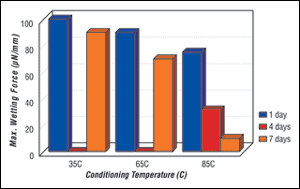
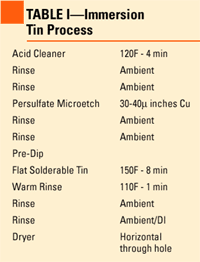
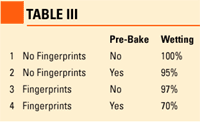
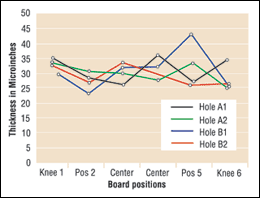
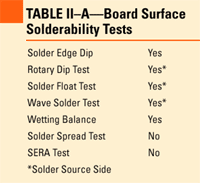
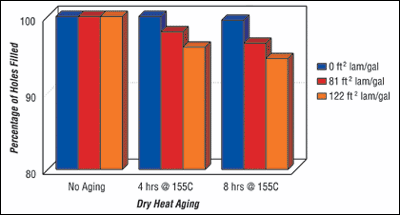

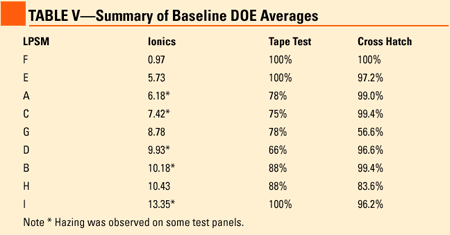
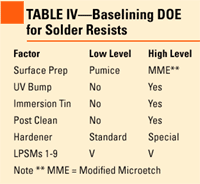
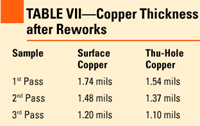
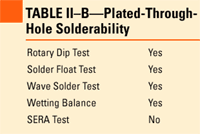









.jpg;maxWidth=300;quality=90)





